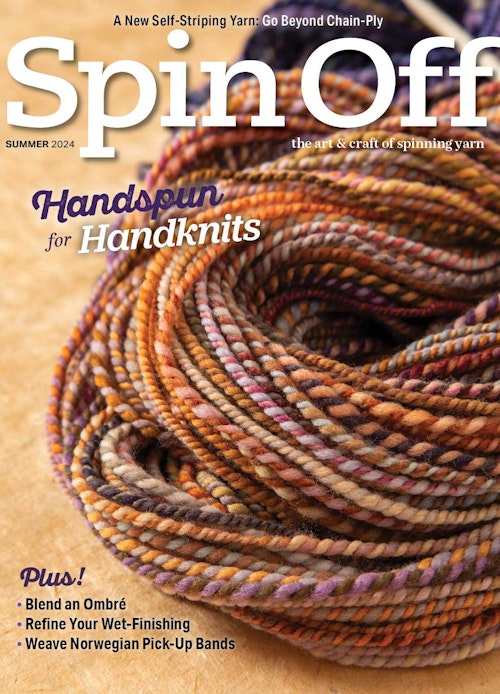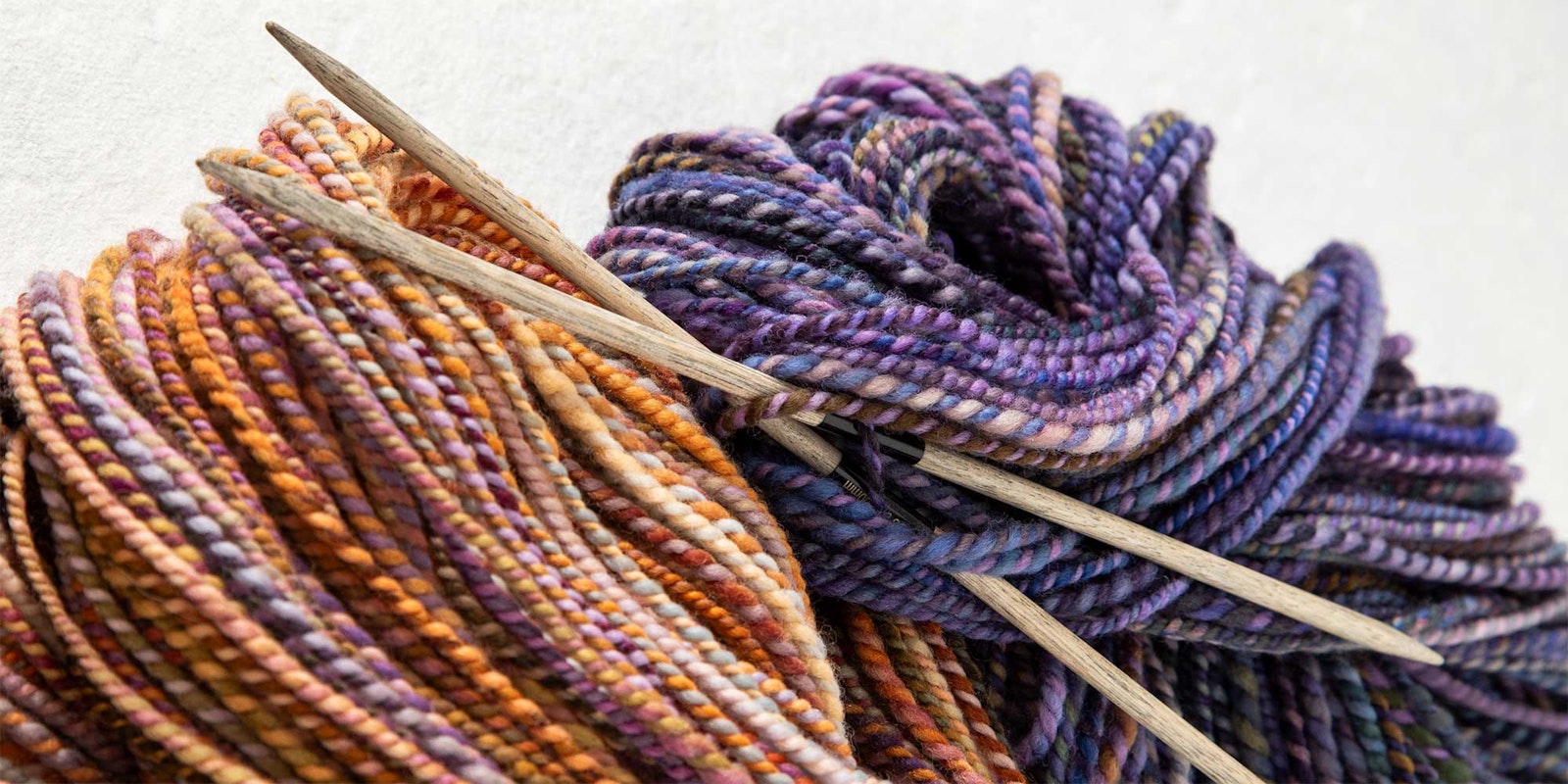For this cheerful Summer issue of Spin Off, we chose the theme “Handspun Handknits” to explore knitting and beyond. The cover features Clarion Overmoyer’s luscious hand-dyed, handspun Merino. We asked Clarion a few questions to learn more about her process and work.
Maker: Clarion Overmoyer
Business name: Clarion Call Fiber Arts
Where to find them: clarionfiber.com
Wheel: Louet S15
Spin Off: It looks like fun to spin groups of skeins in each colorway you’re working on. Do you have any tips for staying consistent from skein to skein?
Clarion Overmoyer: Ahh, consistency—the spinner’s utopian dream! To make this goal more achievable, I’ve found that the following tips help me keep my yarn even as I spin:
1) Prepare. Make sure you prep your fiber well before you start spinning, and it will be easier to work with. Whether you’re working with batts, rolags, top, or roving, predrafting is a great way to open up your fiber—which makes it easier for your fingers to create a more consistent yarn. It also gives you a chance to pull out any bits of vegetable matter or any lumps and bumps that may have been created during a blending or dying process that will turn into slubs as you spin.
2) Persist. When I’m spinning a large batch of fiber for a particular colorway, I try to focus and spin all of it before moving on to another colorway. I rely a lot on muscle memory as I draft to keep my singles a consistent weight, and I’ve noticed if I leave a colorway for a while and come back to it after a long break, my yarn weights start to vary. Beginning spinners, don’t worry! Keep practicing, and you’ll develop your muscle memory, too.
 (Left to right) Clarion on her balcony, spinning. A skein of Clarion’s handspun in the Parasol colorway. Courtesy of Clarion Call Fiber Arts
(Left to right) Clarion on her balcony, spinning. A skein of Clarion’s handspun in the Parasol colorway. Courtesy of Clarion Call Fiber Arts
3) Appreciate. I’m a very detail-oriented person who gets frustrated when things aren’t perfect, so as you can imagine, when I first started spinning I was hyper focused on making my yarn perfectly even. What I’ve learned over time is that micromanaging yourself and stressing about slubs takes a lot of the joy out of spinning. Now when I spin, I try to turn off my brain and use spinning as a kind of meditation exercise. I try to focus on how the fiber feels running through my fingers, enjoy the colors mixing together as the fiber twists, and listen to the soothing noise of the wheel as it spins. I do my best to keep my yarn consistent, but if it’s not perfect, so what? It’s handspun! The imperfections make it special.
SO: Can you tell us a bit about your recycled yarn, how you got started, and what you use to respin it?
CO: I’m so inspired by the creative ways that crafty people repurpose unwanted things to make beautiful, new, and useful items. I knew early on that I wanted to somehow make recycling a part of my business.
Knitting was my gateway craft. Since I also work with costumes in my day job, it comes naturally to me to know how sweaters get put together (and, consequently, how they come apart). Through this, I got the idea to begin salvaging unwanted sweaters for their yarn. If you’ve ever frogged a sweater, you know that afterward the plies of the yarn sometimes lose their twist and spread apart. When this happened to me, I found the yarn harder to knit with; I realized that quickly running the yarn through my spinning wheel fixed the problem.
 Clarion’s handspun colorway Monet’s Lillies works up into a beautiful knitted swatch with lovely pink and purple gradients. Courtesy of Clarion Call Fiber Arts
Clarion’s handspun colorway Monet’s Lillies works up into a beautiful knitted swatch with lovely pink and purple gradients. Courtesy of Clarion Call Fiber Arts
When I recycle sweaters, I use the biggest whorl on my jumbo bobbin and tighten the brake screw to increase the uptake. With this setup, I can use my Louet wheel to both frog a sweater and respin the yarn at the same time. I believe that every sweater deserves a second chance—so in addition to wool, I also recycle a lot of cotton blends and acrylic sweaters. After respinning, I always soak my reclaimed yarn in a hot, soapy bath, wring it out, and hang to dry. This helps calm down the kinks from the yarn’s past life. I’m always proud when my respun yarn comes out looking brand new!
I’m incredibly passionate about environmental conservation, and I happily share my techniques so that others can save their unwanted sweaters from landfills, too. My series of YouTube Tutorials, How to Reclaim Your Old Sweaters for Their Yarn, details how I tackle taking apart a sweater.

Many thanks to Clarion for giving us a peek at her processes! You’ll find even more to love in the Summer 2024 issue, including these highlights:
Swedish Spinner Josefin Waltin had woven with her handspun linen in the past, but she discovered a twist conundrum once it was on her knitting needles. Check out her article to see how she fixed her bias! You can further harness the power of twist by using S- and Z-spun singles to create self-striping yarns, perfect for the Bari Tee by Sarah Solomon. And Kim McKenna is back to share the finer points of wet-finishing so you can get those hanks ready to cast on.
 Kim McKenna used five breeds of wool dyed in the Morning Glow colorway by Crafty JAK’s to explore four different wet-finishing methods.
Kim McKenna used five breeds of wool dyed in the Morning Glow colorway by Crafty JAK’s to explore four different wet-finishing methods.
Travel to Peru with Dr. Carrie Brezine to learn about cotton stockings left behind by sixteenth-century knitters, and make your own pair with Devin Helmen. We are also excited to share an excerpt from Annemor Sundbø’s newest book about Norwegian sweaters, and Angela K. Schneider wrote instructions for the woven pick-up band that adorns a Norwegian-made sweater from a collection at Vesterheim National Norwegian-American Museum.
 Learn to create self-striping yarns, then knit the Bari Tee.
Learn to create self-striping yarns, then knit the Bari Tee.
No matter your textile interests—spinning for knitting, weaving, crochet, embroidery, and more—we hope this issue inspires you to use your yarn this summer!
Ready to explore this issue? Get your copy of Spin Off Summer 2024 by subscribing today or purchasing this issue from our online shop.

